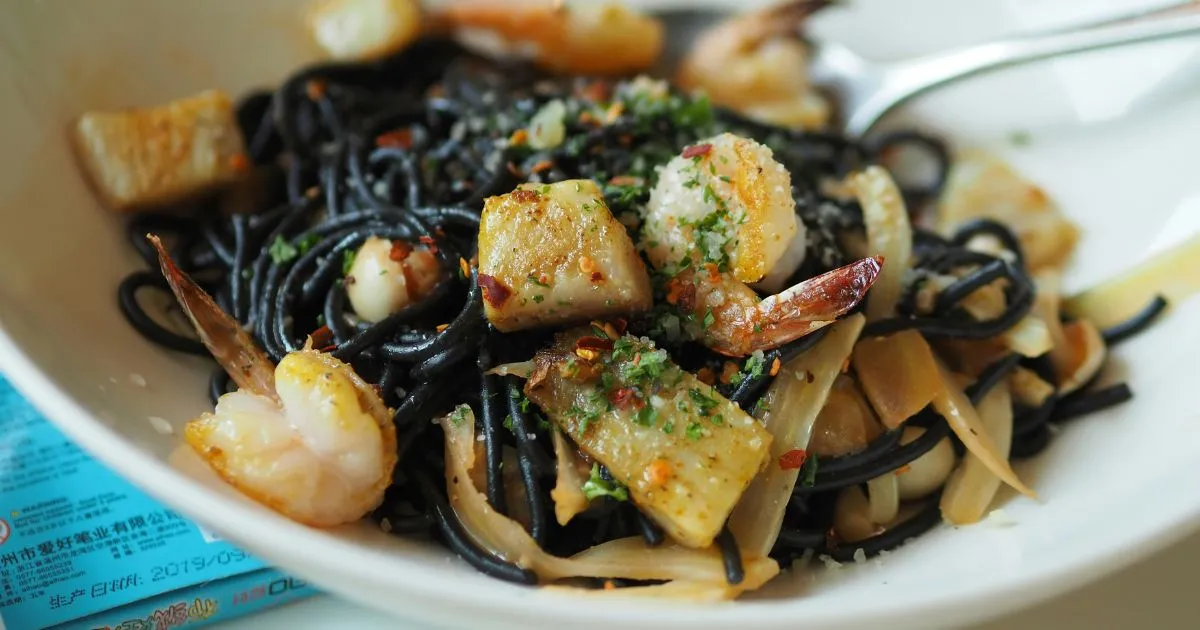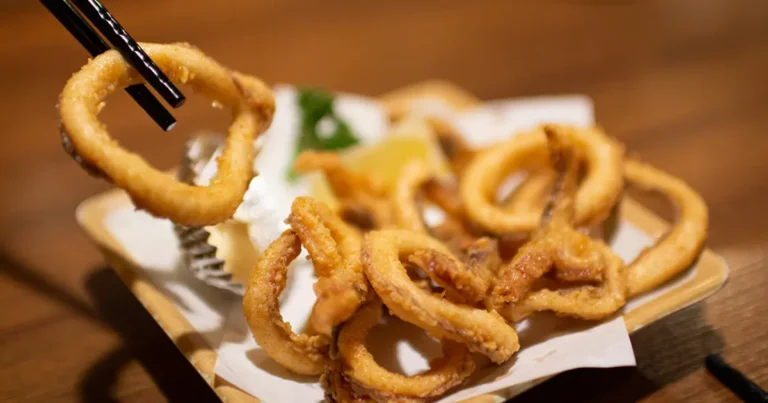How to Make a Squid Ink Pasta Recipe at Home (Step-by-Step)
Table of Contents
Preparing squid ink pasta at home is both enjoyable and satisfying. This Italian dish is famous for its striking look and rich taste. With just a few ingredients and basic tools, you can create this unique pasta yourself.
First, gather your ingredients and tools. You’ll make a dough with squid ink. This gives the pasta its unique color and taste. By following a step-by-step guide, you can make it look like a pro in your kitchen.
Key Takeaways
- Learn to make squid ink pasta from scratch at home.
- Understand the essential ingredients and equipment needed.
- Follow a step-by-step guide to creating this unique Italian dish.
- Discover the benefits of making pasta at home.
- Impress your guests with a visually stunning and flavorful meal.
What is Squid Ink Pasta?
Squid ink pasta is celebrated for its rich, savory flavor and bold black color. It’s a hit in many Italian restaurants. It’s often found in dishes that highlight seafood.
The Origins and Culinary History
Squid ink pasta originates from the Mediterranean, particularly Italy and Spain. For ages, squid ink has been used to flavor and color dishes. It’s mixed with flour and eggs to make the pasta, giving it a unique look and taste.
Flavor Profile and Characteristics
Squid ink pasta has a deep, umami-rich flavor with a savory finish. It goes well with seafood, especially when seasoned with garlic, olive oil, and herbs. The squid ink not only colors the pasta but also boosts its umami flavor. That makes it perfect for dishes like spaghetti with squid ink.
Ingredients for the Perfect Squid Ink Pasta Recipe
Making the perfect squid ink pasta starts with the right ingredients. You’ll need traditional pasta ingredients and squid ink for this dish.
Essential Ingredients List
The base of your squid ink pasta is its ingredients. Here’s what you’ll need:
- Use “00” or Caputo flour to achieve a smooth, tender pasta texture.
- Eggs, preferably fresh and large, for moisture and richness
- Squid ink is the key ingredient that infuses the pasta with its signature color and distinctive flavor.
- Salt to enhance the overall taste
- Olive oil to help bind the ingredients together
Quality matters. “00” flour, or caputo flour, makes your pasta finer. Fresh eggs add moisture and richness.
Where to Find Squid Ink
Finding squid ink can be tricky, but it’s out there:
- Specialty seafood stores or fish markets
- Italian or gourmet food stores
- Available through online stores like Amazon or gourmet food websites.
Make sure to buy high-quality squid ink. Some brands offer it in easy-to-use packets.
Equipment You’ll Need
To make squid ink pasta at home, you need the right tools. You’ll need basic tools and some special equipment. These help you get the perfect texture and flavor.
Basic Tools for Hand-Rolling
For hand-rolling, you’ll need a few key tools. Gather a large mixing bowl, a wooden spoon or spatula, and a clean surface for kneading the dough. A rolling pin is also needed to flatten the dough to the right thickness.
- A large mixing bowl for combining ingredients
- A wooden spoon or spatula for mixing
- A clean surface for kneading the dough
- A rolling pin for flattening the dough
Using a Pasta Machine
Using a pasta machine can give you a uniform texture. A pasta machine allows you to roll the dough to an exact thickness, ensuring even cooking and a smooth, professional finish.
Simply feed the dough through, gradually reducing the thickness setting until you reach the desired result. Whether you hand-roll or use a machine, the right equipment is essential for making tasty squid ink pasta at home.
Preparing Your Squid Ink Pasta Dough
Making squid ink pasta starts with the dough. You mix, knead, and rest the dough. This step is essential to get the ideal texture and taste.
Mixing the Ingredients
Start by combining ’00’ flour, eggs, squid ink, and a pinch of salt in a large bowl, using one egg per 100 grams of flour. Gradually add squid ink to achieve the desired color and flavor.. Mix with a fork until it’s a shaggy dough.
Kneading Techniques
Kneading makes the dough chewy. Transfer the dough to a floured surface and knead for approximately 10 minutes. It should be smooth and elastic. A stand mixer fitted with a dough hook can also be used to make the process easier.
Resting the Dough
After kneading, wrap the dough in plastic or a damp cloth.Allow the dough to rest for a minimum of 30 minutes. This makes the dough easier to roll out. Then, you can shape it into pasta.
- Make sure the dough is thoroughly kneaded to achieve the best texture.
- Don’t skip the resting time for better roll-out.
- Use ’00’ flour for a more tender pasta.
Step-by-Step Rolling and Cutting Process
Now that you’ve made your squid ink pasta dough, it’s time to shape it. This step is key to getting the right texture and taste for your squid ink pasta.
There are two main ways to roll out your pasta dough. You can roll the dough by hand or use a pasta machine for convenience. The choice depends on what you prefer and what tools you have.
Hand-Rolling Method
The hand-rolling method gives your pasta a rustic, homemade feel. To do this, follow these steps:
- Cut the dough into smaller portions to make rolling more manageable.
- Use a rolling pin to flatten the dough to your liking.
- Shape the dough into a tight log, then cut it into thin strips.
This method lets you control the pasta’s thickness and texture.
Pasta Machine Method
Using a pasta machine is a more precise way to roll out your dough. It ensures your ink pasta is evenly thick. Here’s how:
- First, lightly press the dough with a rolling pin to flatten it slightly.
- Feed the dough through the pasta machine, starting at the thickest setting.
- Lower the thickness setting and pass the dough through each setting until it’s just right.
- Once it’s rolled out, use the pasta machine’s cutting attachment or a sharp knife to cut it into the shape you want.
A pasta machine makes your pasta uniform, which is great for dishes like shrimp squid pasta.
| Method | Advantages | Disadvantages |
| Hand-Rolling | Rustic texture, more control | Time-consuming, variable thickness |
| Pasta Machine | Uniform thickness, efficient | Requires a pasta machine, less rustic |
Drying and Storing Your Homemade Pasta
After making your squid ink pasta, drying and storing it right is key. These steps help keep your pasta fresh and tasty.
Proper Drying Techniques
You can air-dry or use a food dehydrator to dry your pasta. Air-drying means laying it out on a towel or rack. It’s simple but takes time, often several hours or overnight.
If you’re in a hurry, a food dehydrator can dry it faster. Make sure it’s completely dry to avoid stickiness and mold.
Storage Options for Fresh and Dried Pasta
For optimal freshness, refrigerate fresh pasta in an airtight container for up to two days, while dried pasta should be stored in a sealed container in a cool, dry place. It lasts several months.
| Storage Method | Fresh Pasta | Dried Pasta |
| Refrigeration | Up to 2 days | Not applicable |
| Cool, Dry Place | Not recommended | Several months |
Proper drying and storage allow you to enjoy your pasta for an extended period. A chef once said, “The art of pasta is not just in making it, but also in preserving it for the future.” Proper drying and storage are essential for enjoying your creations whenever you like.
“Pasta is the canvas on which the sauce paints its masterpiece.” Proper drying and storage ensure your canvas remains perfect for your next culinary creation.
Cooking and Serving Squid Ink Pasta
It’s time to cook your squid ink pasta. To enjoy its unique taste and texture, cook it right and pair it well with other foods.
Perfect Cooking Times
Cooking squid ink pasta needs careful timing. It cooks fast, usually in 2-4 minutes in boiling, salted water. To get the perfect al dente texture, watch the time closely. Cooking it too long can make it mushy, so it’s safer to cook it a bit less.
Classic Seafood Pairings
Squid ink pasta goes well with seafood because of its oceanic taste. Two top pairings are shrimp and squid ink pasta, and scallop with butter sauce.
Shrimp and Squid Ink Pasta
Shrimp and squid ink pasta is a perfect match. The delicate sweetness of shrimp creates a perfect harmony with squid ink’s deep, oceanic savor. Cook the shrimp in garlic butter, then mix it with the pasta and parsley for a tasty dish.
Scallop and Butter Sauce
Enhance the flavor by serving squid ink pasta with buttery scallops for a rich, indulgent dish. Cook the scallops until they’re golden, then serve them on squid ink pasta with a lemon butter sauce. This dish is rich and indulgent.
Conclusion
Now you know how to make squid ink pasta from scratch. It’s time to try it out. With practice, you’ll make dishes that wow your loved ones.
For the best results, use top-notch ingredients. Carefully follow each step for mixing, kneading, and drying the pasta to ensure the best results. Experiment with various types of seafood to discover your favorite squid ink pasta combination.
Keep improving your squid ink pasta recipe. Don’t hesitate to try new ingredients and flavors. Soon, you’ll make pasta as good as the best Italian restaurants.
FAQ
Curious about squid ink pasta? Squid ink pasta is a uniquely dark pasta known for its bold flavor—learn what it is and how to make it from scratch.
It’s made by mixing squid ink with “00” flour, eggs, and salt. Then, the dough is kneaded and rolled out into the desired shape.
Where can I buy squid ink for making squid ink pasta?
You can find squid ink at specialty food stores, seafood markets, or online. Also, check with local Italian or seafood restaurants to see if they have it or can order it for you.
Can I use store-bought squid ink pasta instead of making it from scratch?
Yes, store-bought squid ink pasta is a good substitute. But making it from scratch lets you control the ingredients and texture. It’s a fun and rewarding process.
What are some common pairings for squid ink pasta?
Squid ink pasta goes well with seafood like shrimp, scallops, or mussels. Garlic, lemon, and aromatic herbs such as parsley or basil complement it perfectly.
How do I cook squid ink pasta, and what’s the ideal cooking time?
Boil squid ink pasta in well-salted water until achieving that ideal al dente texture. The cooking time varies based on the pasta’s shape and thickness. It’s usually 2-4 minutes.
Can I use squid ink pasta in cold dishes, such as salads?
And Yeah, squid ink pasta works wonderfully in cold dishes such as pasta salads. It adds visual interest and flavor. Just cook the pasta al dente and chill it before using in your salad.



